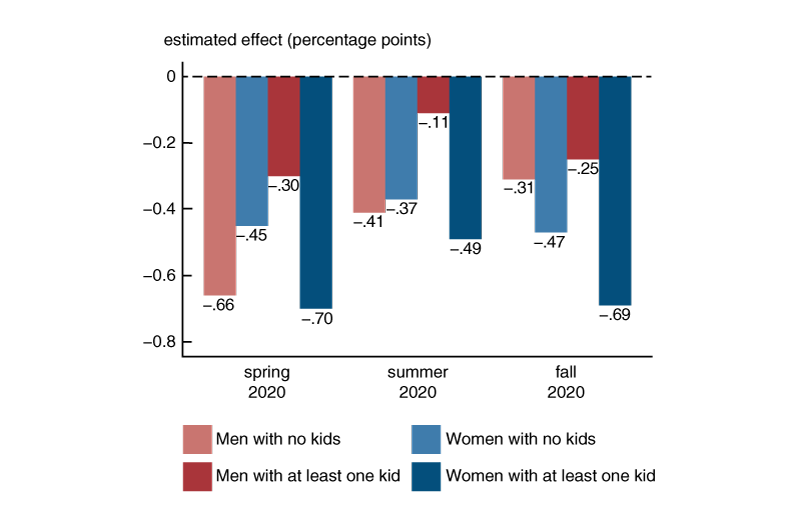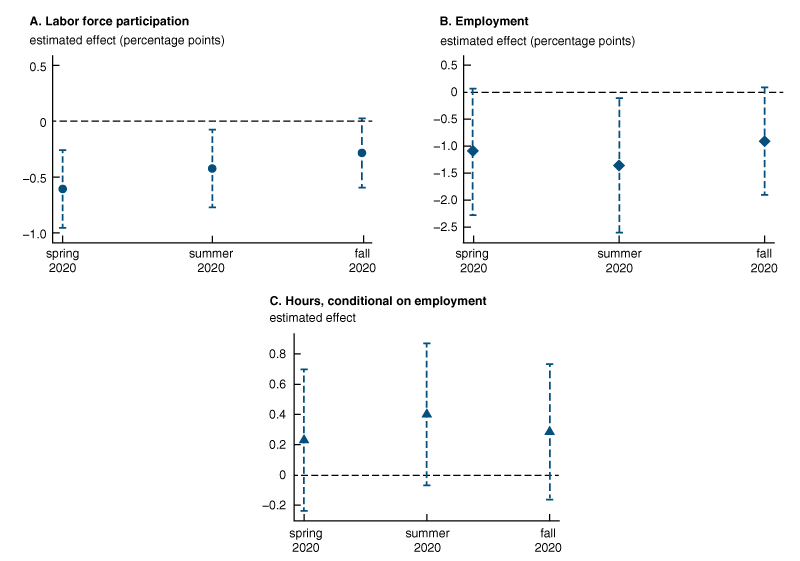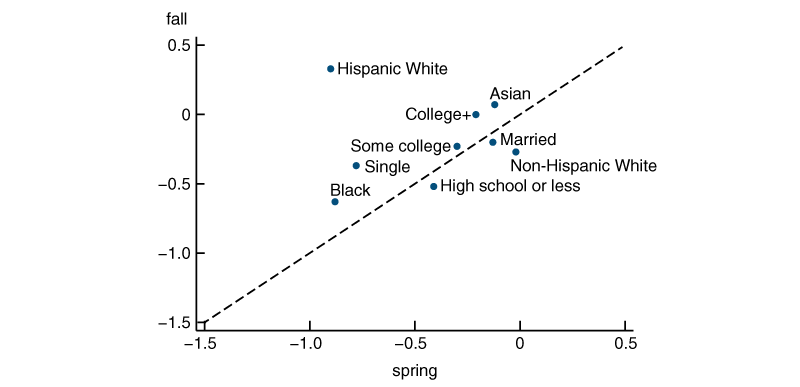School and day care center restrictions during the Covid-19 pandemic have presented enormous challenges to parents trying to juggle work with child-care responsibilities. Still, empirical evidence on the impact of pandemic-related child-care constraints on the labor market outcomes of working parents is somewhat mixed. Some studies suggest the pandemic had no additional impact on the labor supply of parents, while other studies show not only that it did but that the negative impact was disproportionately borne by working mothers.1
In this Chicago Fed Letter, we describe estimates of the impact of the pandemic on prime-age (25 to 54) parents’ labor market activity through the fall of 2020, with a particular emphasis on mothers. We show that the labor force participation (LFP) of mothers, i.e., the share of working-age mothers employed or seeking employment, declined by an additional 0.6 percentage points in the spring and 0.3 percentage points in the fall, above and beyond the negative toll that the pandemic had on labor market attachment of prime-age adults without kids. The impact translates to roughly 120,000 and 60,000 fewer prime-age mothers in the labor force in the spring and fall, respectively. This estimate is more than fully driven by a decline in employment. Indeed, we estimate roughly 200,000 fewer prime-age mothers were employed throughout the pandemic. The largest impact has been on Black, single, and non-college-educated mothers, mirroring widening employment disparities in the broader labor market since March.
Data and methods
We use a conventional statistical model to estimate how labor market activity was impacted by the pandemic. The model takes the general form:
$${{Y}_{it}}={{\unicode{x03B2}}_{0}}+{{\unicode{x03B2}}_{1}}{ }{({Period}_{t})}+{{\unicode{x03B2}_{2}}}({{Period}_{t}}\times{{Female}_{i}})+{\unicode{x03B2}_{3}} ({{Period}_{t}}\times{{HasKid}_{i}})$$ $$+{{\unicode{x03B2}}_{4}} ({{Period}_{t}}\times{{Female}_{i}}\times{{HasKid}_{i}}) + {\unicode{x03B4}}{{X}_{it}} + {{\unicode{x03B5}}_{{it}^{\bullet}}}$$
In words, a person ${i}$’s labor market outcome—say, whether they are participating in the labor force—in a given month ${t}$ (which we denote ${{Y}_{it}}$) depends on whether that person is being observed in one of three pandemic periods: March to May 2020 (which we refer to as the spring school semester), June to August 20202 (summer), or September to November 2020 (fall school semester). The coefficient ${{\unicode{x03B2}}_{1}}$ in front of our pandemic variable (${{Period}_{t}}$) measures the extent to which labor market activity changed during the three seasons of the pandemic thus far, relative to the pre-pandemic January 2019 to February 2020 period.
Our focus is on isolating how parents’ labor market outcomes changed during the pandemic. These effects are measured by the coefficients in front of three interaction terms: ${{Period}_{t}}\times{{Female}_{i}}$, ${{Period}_{t}}\times{{HasKid}_{i}}$, and ${{Period}_{t}}\times{{Female}_{i}}\times{{HasKid}_{i}}$.
In combination, they provide the estimated effect of the Covid-19 shock on the labor supply of individuals with and without kids for both men and women.3 Of particular importance is the coefficient ${{\unicode{x03B2}}_{4}}$, which measures the additional effect on women with kids. We refer to this as a triple-difference estimate because it picks up the differential impact between mothers and fathers while adjusting for any differential gender-related impact between women and men without kids.
A rich set of controls, ${{X}_{it}}$, account for an individual’s race, age, education, whether there is a spouse in the household, state of residence, and typical industry and occupation.4 The purpose of these controls is to purge other possible observable explanations for changes in labor market activity during the pandemic. Later, we briefly discuss how our results vary by observable characteristics of parents, such as single versus married and high school versus college graduates.
We estimate this regression using the U.S. Bureau of Labor Statistics’ Current Population Survey (CPS) over the period January 2019 to November 2020. The CPS is a monthly survey of 60,000 households. We restrict our sample to individuals aged 25 to 54, of which there are, on average, roughly 45,000 per month. We discuss results for three labor market outcomes: whether the individual is in the labor force (either employed or unemployed); whether the individual is employed; and, for those working, how many hours they work per week.
Results
Figure 1 plots the average decline in labor force participation, after conditioning on the ${{X}_{it}}$ controls, for men and women with and without school-aged kids during 2020. The left four bars represent estimates for the spring (March–May), the middle four bars are for the summer (June–August), and the right four bars are for the fall (September–November). Among women with children, the pandemic lowered labor force participation by 0.7 percentage points in the spring and fall and 0.5 percentage points in the summer. By comparison, the LFP of men with kids fell a more modest –0.3, –0.1, and –0.3 percentage points in the spring, summer, and fall, respectively. Therefore, the difference between fathers and mothers was a consistent 0.4 percentage points throughout the year.
1. Labor force participation during the pandemic, by gender and children

This gender disparity is not nearly as stable among prime-age individuals without kids. Indeed, in the spring and summer, the LFP decline was larger among men without kids than among women without kids. That pattern reversed in the fall. Still, this past fall’s 0.16 percentage point difference between women (–0.47 percentage points) and men (–0.31 percentage points) without kids is less than half the 0.44 percentage point difference between mothers and fathers. Our preferred “triple-difference” estimate of the impact on mothers with kids—or again the difference between women and men with kids minus the difference between women and men without kids—is shown in the left panel of figure 2. The pandemic lowered the labor force participation rate of mothers by an additional 0.6 percentage points during the school months in the spring, 0.4 percentage points in the summer, and 0.3 percentage points in the fall. These estimates are all statistically different from zero (the dashed vertical lines are 95 percent confidence bands). For economic context, the labor force included roughly 19.5 million prime-age mothers of children under age 14 in 2019. Therefore, every 0.1 percentage point decline in LFP corresponds to approximately 19,500 women.
2. Impact on women with children: Labor force participation, employment, and hours

Source: Authors’ calculations based on data from the U.S. Bureau of Labor Statistics, Current Population Survey.
In the middle panel of figure 2, we report the corresponding triple-difference decline in prime-age mothers’ employment was roughly 1 percentage point, and statistically different from zero, throughout the year. These are economically sizable effects; 1 percentage point translates to roughly 190,000 prime-age mothers. The employment losses are larger than the LFP losses because the pandemic led to an increase in the number of unemployed mothers.
Finally, in the right panel, we plot the impact of the pandemic on mothers’ hours worked among those working. Working mothers report somewhat longer schedules—about 15 to 30 minutes more per week—but relative to the mean workweek of 37.5 hours, this effect is economically small.
Variation by demographics
Both school and day care center closures have been disruptive for working parents. To get some feel for how much may be due to each, we reran our LFP estimates for two samples: prime-age parents with a child under age five and prime-age parents whose youngest child is school age (between ages five and 13). We find a somewhat larger pandemic effect on mothers with children under five. But the difference is economically small and statistically insignificant. For example, the pandemic lowered the labor force participation rate of mothers with preschool-age kids by an additional 0.68 and 0.34 percentage points in the spring and fall, respectively. By comparison, the effect on mothers with school-age kids was 0.56 and 0.25 percentage points, respectively, in the spring and fall.
Finally, we examined the pandemic’s impact on the LFP of mothers by race, education, and marital status subgroups. For this exercise, we restrict the sample to women.5 Figure 3 plots our estimates for the spring (horizontal axis) and fall (vertical axis). The dashed 45-degree line represents spring and fall estimates that are the same size. Above the dashed line, the LFP effect improved between spring and fall; and below the line, it got worse.
3. LFP of women with children, spring and fall 2020, by demographic groups

Source: Authors’ calculations based on data from the U.S. Bureau of Labor Statistics, Current Population Survey.
Perhaps the most striking pattern is the persistent damage to labor market participation among Black (say, relative to non-Hispanic White), single (relative to married), and high-school-educated (relative to college-educated) mothers. While small sample sizes do not allow for the power to find statistical differences between most groups,6 the patterns appear to mirror widening employment disparities observed in the broader labor market since March. Still, most groups, including Black and single mothers, have seen some improvement in labor market attachment since the spring; that improvement is especially notable among White Hispanic mothers, who had the largest LFP decline in the spring but the smallest (and back to pre-pandemic levels) in the fall. By contrast, the LFP effect among non-Hispanic White mothers grew somewhat larger in the fall.
Summary
Recent research has documented a long-run trend in the U.S. toward women’s labor supply behavior looking more and more like that of men.7 However, there have been tangible differences during the pandemic. In particular, mothers’ labor force participation declined by an additional 0.6 percentage points in the spring and 0.3 percentage points in the fall, and their employment was roughly 1 percentage point lower throughout the first nine months of the pandemic. These labor market effects have been larger among single, Black, and non-college-educated mothers. While we do not discuss the channels here, other research has noted that some of the gender disparity could be explained by a higher share of women employed in sectors, such as leisure and hospitality, which have been devastated by the pandemic. While we control for indicators of industry and occupation, and can show that this explains some of the disparity, finer dimensions of sector and job type undoubtedly could matter. Others point to persistent social norms of mothers as primary caregivers, which have come into sharp focus with school and day care center restrictions. Household inequities may have been further exacerbated by health restrictions that limited people’s ability to rely on extended family members or others for help. Given the persistence of the effects thus far, it would be somewhat surprising to see much of a reversal until schools and day care facilities normalize their operations. Even then, it is an open question as to whether gaps in labor market attachment that have opened up during the pandemic may lead to longer-run obstacles in the labor market.
Notes
1 On no impact, see, e.g., Scott Barkowski, Joanne Song McLaughlin, and Yinlin Dai, 2020, “Young children and parents’ labor supply during COVID-19,” Clemson University and University at Buffalo, research paper, July 27, Crossref, and Misty L. Heggeness, 2020, “Estimating the immediate impact of the COVID-19 shock on parental attachment to the labor market and the double bind of mothers,” Review of Economics of the Household, Vol. 18, No. 4, December, pp. 1053–1078, Crossref. On an impact, see, e.g., Titan Alon, Matthias Doepke, Jane Olmstead-Rumsey, and Michèle Tertilt, 2020, “The impact of COVID-19 on gender equality,” National Bureau of Economic Research, working paper, No. 26947, April, Crossref, and Liana Christin Landivar, Leah Ruppanner, William J. Scarborough, and Caitlyn Collins, 2020, “Early signs indicate that COVID-19 is exacerbating gender inequality in the labor force,” Socius: Sociological Research for a Dynamic World, Vol. 6, January–December, Crossref.
2 The Current Population Survey interview occurs during the week of the 12th. We decided to include August in the summer since most schools began in the second half of that month.
3 ${{\unicode{x03B2}}_{1}}$ gives the estimated effect on labor force participation of men with no kids; ${{\unicode{x03B2}}_{1}}+{{\unicode{x03B2}}_{2}}$ is the effect on women with no kids; ${{\unicode{x03B2}}_{1}}+{{\unicode{x03B2}}_{3}}$ provides the estimated effect on men with at least one school-aged kid; ${{\unicode{x03B2}}_{1}}+{{\unicode{x03B2}}_{2}}+{{\unicode{x03B2}}_{3}}+{{\unicode{x03B2}}_{4}}$ gives an estimate of the effect on women with at least one school-aged kid.
4 To control for seasonal patterns, we also include time-period fixed effects (for March–May, June–August, and September–December) and their interactions with ${{Female}_{i}}$, ${{HasKid}_{i}}$, and ${{Female}_{i}}\times{{HasKid}_{i}}$.
5 The regression specification is otherwise similar to our triple-difference analysis (e.g., we include all relevant controls), but here we are interested in the coefficient estimate on the interaction term ${{Period}_{t}}\times{{HasKid}_{i}}$. This estimate gives the difference in the effect on labor force participation of women with kids relative to women with no kids within a particular demographic group.
6 Exceptions are Hispanic Whites versus non-Hispanic Whites and single versus married mothers, but only in the spring.
7 See Bradley T. Heim, 2007, “The incredible shrinking elasticities: Married female labor supply, 1978–2002,” Journal of Human Resources, Vol. 42, No. 4, Fall, pp. 881–918. Crossref










